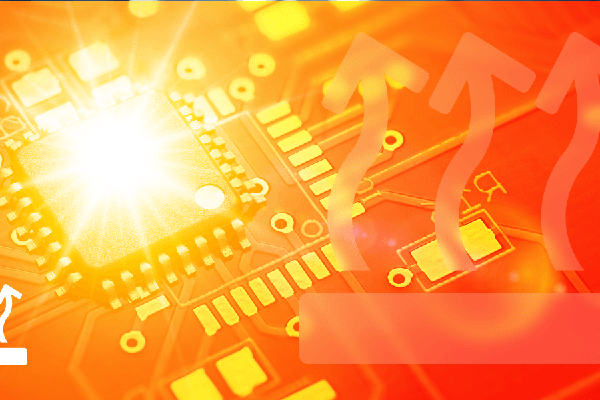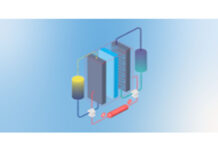Thermal management is critical in several industries, and the trends in emerging technologies are driving material innovation. Electronics in markets from personal devices through to cars are seeing increased integration, densification, and hence an increased focus on thermal management. As these components have less and less free space to utilize, the use of materials that provide more than one function is on the rise.
Electric Vehicle Battery Evolution
The electric vehicle (EV) market has continued its trend toward higher energy-density battery designs. While the average market energy density has decreased slightly since 2020 due to the resurgence of LFP batteries, the percentage of the battery that is taken up by the cells has been increasing, somewhat mitigating the hit from adopting the lower energy density cell chemistry.

The trend of increasing packing efficiency is partly due to incremental improvements but also greater adoption of cell-to-pack and cell-to-body designs that have been seen in 2022. BYD’s Blade battery has seen a greatly increased deployment in 2022, with BYD’s market share in China’s EV market reaching approximately 25% in the first half of 2022. This cell-to-pack design has each prismatic cell take up the entire width of the pack. In 2022, Tesla has also deployed its first vehicles using the fabled 4680 battery cells and a structural pack design where the seats are attached directly to the lid of the battery. These design changes greatly improve energy density by removing ancillary materials that do not directly contribute to the battery’s operation. Several OEMs have announced plans for cell-to-pack or cell-to-body designs to be deployed within the next few years, including groups like VW, Stellantis, and several others.
Fire Protection in Future Battery Designs
Despite the removal and reduction of materials in EV batteries, there are several materials that will always be required in an EV battery design for it to function optimally. These include the thermal management strategy (cold plates, coolants, etc.) and, critically, in 2022, fire protection materials. Similar to 2021, EV fires have been prominent in news outlets but, now more than ever, a driver for material innovation. While fires are a rare event and less likely to occur than in a combustion engine vehicle, Li-ion batteries, regardless of chemistry or cell format, present a non-zero risk of thermal runaway and subsequent fire. 2021 saw several recalls relating to battery fire risks from major OEMs, including GM, Hyundai, VW, and others. In 2022, India has seen a large focus on battery fires in electric two-wheelers, which has prompted the adoption of specific safety standards relating to several battery design factors.
With the public focus and impending implementation of thermal runaway safety regulations in various regions, OEMs are forced to consider materials used for fire protection more carefully. The previously discussed trend towards cell-to-pack and higher energy density packs presents a challenge in fire protection. As energy density increases, there is less space for added materials, leading to suppliers focusing on multifunctional materials. For example, aerogels are gaining traction in the market thanks to their ability to provide thermal insulation, fire protection, and compressibility. In 2022, Aspen Aerogels was named as the supplier for GM’s Ultium platform, and its PyroThin material reported revenue of US$18.4 million in the first half of 2022 compared to US$6.7 million for all of 2021. Rogers Corporation, a prominent player in providing compression foam pads for pouch cell battery packs in 2022, announced its EV ProCell Firewall materials that provide both fire protection and compression management (critical for pouch cell battery packs). An acquisition of Rogers by DuPont was announced in late 2021 as one of the largest acquisitions in the materials space in recent history. However, this acquisition was terminated at the end of 2022 after DuPont failed to obtain clearance from all the required regulators
Several other material options can be used depending on the cell format and whether an inter-cell and/or a pack level solution are required. In 2023 and beyond, with the rapidly expanding EV market, several of these materials will experience rapid growth in demand, and IDTechEx is predicting a 13-fold increase in fire protection material demand by 2033. IDTechEx’s latest report, “Fire Protection Materials for Electric Vehicle Batteries 2023-2033”, analyzes trends in battery design, safety regulations, and how these will impact fire protection materials. The report benchmarks materials directly against each other and for applications within battery packs. The materials covered include ceramic blankets/sheets (and other non-wovens), mica, aerogels, coatings (intumescent and other), encapsulants, encapsulating foams, compression pads, phase change materials, and several others. 10-year market forecasts are included by material and vehicle category.

The Evolution of Thermal Interface Materials in EV Batteries
Thermal interface materials are a critical component in the vast majority of modern EV battery designs. These help to dissipate heat from the cells towards the cooling structure (module housings, cooling, channels/cold plates). The most common applications currently have the battery cells sit on a gap-filling TIM inside a module; several of these modules then sit on another gap-filling TIM to contact the liquid-cooled cold plate below. This approach has changed in some more recent designs, especially cell-to-pack designs.
The concept is to have the cells contact the cold plate directly through a single TIM, reducing the number of interfaces and hence improving heat transfer. Due to less interfaces, the thermal conductivity of the TIM can be reduced, and less TIM is required. Initially, this can reduce the weight and cost of the TIM and make for easier dispensing. However, with the removal of module housings (or similar structures), the TIM must now provide a structural component. Therefore, this is a great opportunity for thermally conductive adhesives.
While (as above) materials around battery cells are being removed from the pack to enable greater energy density, the TIM is one that will largely remain and provide multifunctional properties to aid in both thermal management and structure of the battery pack. With larger form factor cells, the area for TIM to be applied may reduce somewhat for certain designs, but IDTechEx is predicting over 2TWh of liquid or refrigerant-cooled batteries by 2031, providing huge growth for TIMs along with several other thermal management components and materials. IDTechEx’s report “Thermal Management for Electric Vehicles 2023-2033” details the OEM strategies, trends, and emerging alternatives around the thermal management of Li-ion batteries, electric traction motors, and power electronics. IDTechEx also provides a report titled “Thermal Interface Materials 2021-2031: Technologies, Markets and Opportunities” that considers TIM application in EV batteries, but also 4G/5G infrastructure, LEDs, data centers, and consumer electronics.
Combining Thermal Management and Electromagnetic Shielding in 5G and ADAS
Several industries are moving towards higher frequency. Two key examples of this are 5G telecommunications for higher data transfer rates and automotive radar to enable higher resolution detection. At higher frequencies, electromagnetic interference (EMI) shielding becomes more challenging with traditional methods. Combine this with increasing component density and power, and materials that can provide both thermal management and EMI shielding become an increasingly interesting proposition.
5G rollout is well underway, but the highest frequency, mmWave (>24GHz) infrastructure, is still in its infancy. The vast majority of 5G infrastructure in 2022 is still in the lower frequency bands below 6GHz. However, IDTechEx predicts a 70-fold increase in mmWave small cell rollout by 2033. mmWave infrastructure presents a host of challenges around signal propagation, but also, the higher frequency leads to smaller, more densely packed antenna where both thermal management and EMI shielding are a challenge.
Automotive radar is one of the key components of advanced driver-assistance systems (ADAS) and an enabling technology for future autonomous vehicles. Previous automotive radar units were largely utilizing 24GHz. Since then, the market has largely transitioned to >77GHz. This helps increase the resolution but also creates a more compact antenna and hence radar unit. These higher-frequency radars will be the dominant technology in the future. IDTechEx estimates that over 90% of automotive radar will be in the 77GHz region by 2030. In these designs, the compact nature of the device with higher frequency signals once again provides challenges to both thermal management and EMI shielding.
Traditional EMI shielding typically consists of a metal board level shield (BLS) placed over the component with a thermal interface material (TIM) used between the component and the shield and then another between the shield and a heat sink. These shields often have holes in to help with heat dissipation, but at higher frequencies (shorter wavelengths), this greatly reduces the EMI effectiveness of the shield. Additionally, having multiple interfaces between the component and the heat sink means that heat transfer is much less efficient. Several material companies have presented a solution to these problems, where a TIM is provided that also has EMI shielding properties.

Several players, such as Henkel, Kitagawa, and Schlegel, have all released TIM pads that also function as EMI shields. An option that stands out in 2022 is the announcement of Laird’s CoolZorb D. Like others, this is a combined EMI shield and TIM but differs as it comes in the form of a 1-part dispensable material. The material provides a thermal conductivity of 3.5W/m×K and high attenuation, especially above 20GHz. The dispensable nature means it is potentially better suited to larger volume manufacturing to help automate the production process. While these combined EMI/TIM options are more expensive than a similar TIM, the ability to remove the EMI absorbing material can lead to a lower cost of device overall in addition to a simpler manufacturing process.
5G and automotive radar are both rapidly growing markets with a transition to higher frequencies. IDTechEx is predicting over 12 million 5G stations in 2032 that will require thermal management and that the yearly market value for TIMs in ADAS will increase 11-fold over the next ten years.
IDTechEx’s report “Thermal Management for Advanced Driver-Assistance Systems (ADAS) 2023-2033” covers trends in ADAS sensor and computer evolution with a focus on thermal interface materials and die attach with additional chapters on combined EMI and thermal materials and radar radome materials. The IDTechEx report on “Thermal Management for 5G 2022-2032” addresses the trends in 5G deployment and how this impacts the antenna design, choice of semiconductor technology, die attach materials, and thermal interface materials. Both technological aspects and market forecasts are included for the next ten years. Additionally, it considers many smartphones and how the incorporation of 5G is impacting thermal materials (interface and heat spreaders).















